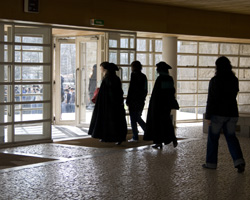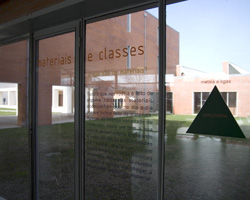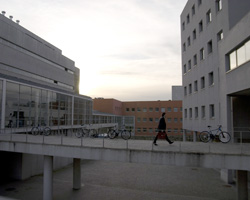MAPFis Courses 2011/2012
(1st Semester)
Tópicos Avançados de Física I (Advanced Topics in Physics I)

Contacts:
Antonio.Onofre@cern.ch; miguelc@fc.up.pt; alfredo.rocha@ua.pt; joao.dias@ua.pt; vbrazhnyy@fc.up.pt; ypogorel@fc.up.pt; apleite@fc.up.pt; bernardo@fisica.uminho.pt; peter.schellenberg@fisica.uminho.pt; Nuno.Castro@cern.ch
Course 1: Experimental Particle and Astroparticle Physics
Lecturers: António Onofre/ Nuno Castro
Programme:
- Introduction to the Standard Model (AO+NC)
•Introduction: matter and forces
•Non relativistic quantum mechanics and special relativity
•Electromagnetic interactions of spin-0 particles
•Electromagnetic interactions of spin 1/2 particles
- Introduction to the Standard Model (NC)
•Weak interactions of quarks and leptons
•Introduction to Quantum Chromodynamics
•Experimental tests of the Standard Model
- Neutrino Physics and Astroparticles (AO)
Neutrino Physics and Astroparticles:
•Neutrino Physics
•Atmospheric and solar neutrinos
•Phenomenology of Neutrino Oscillations
•Neutrino Oscillation Experiments
•Neutrino puzzles: LSND anomaly and MiniBoone results
•Neutrino mass
•The futur: super-beams and neutrino-factories
Cosmic Rays
•The cosmic ray spectrum and cosmological sources
•Ultra-high-energy (UHECR) cosmic rays
•The GZK cut-off
•Experiments and detectors of UHECR
- Hadron Collider Physics (AO+NC)
•History of hadron colliders
•Hadron collider observables and differential distributions
•Cross sections and decay rates
•Elastic and inelastic collisions of hadrons
•Minimum bias and soft underlying events
•PDF and heavy flavour production (top and bottom quarks)
•Vector boson production at hadron colliders
•Special probes of the Standard Model: why is the top quark so interesting?
•The Higgs search
- Final Remarks and Evaluation
Objectives:
1.Provide basic knowledge on the Standard Model and its experimental tests
2.Make a brief introduction to Collider Physics and explore examples of colliders (the LHC)
3.Introduce the students to Neutrino Physics and compare different experimental techniques for detection of neutrino oscillations
4.Explore the Cosmic Ray spectra with special focus to the ultra high energy region.
Evaluation: Project research work (based also on IDPASC material)
Bibliography:
1.I.J.R. Aitchison and A.J.G Hey, “Gauge theories in particle physics”, Vols. I and II, IoP publishing, 3rd Ed. (2003).
2.F. Halzen and A.D. Martin, “Quarks and leptons: an introductory course in modern particle physics”, Wiley (1984).
3.D.M. Gingrich, “Practical Quantum Electrodynamics”, Taylor and Francis (2006).
4.David J. Griffiths, “Introduction to Electrodynamics”, 3rd Edition, Prentice Hall, Upper Saddle River, New Jersey 07458
Additional usefull text books:
1. R.K. Ellis, W.J. Stirling and B.R. Webber, “QCD and collider physics”, Cambridge (1996).
2. E.A. Paschos, “Electroweak Theory”, Cambridge (2007).
3. B.R. Martin and G. Shaw, “Particle physics”, Wiley (1992).
4. W.S.C. Williams, “Nuclear and particle physics”, Oxford (1991).
5. S. Eidelman et al., “Review of particle physics”, Physics Letters B 592 (2004) 1.
6. J.D. Bjorken and S.D. Drell, “Relativistic Quantum Mechanics”, McGraw (1964). e.g. G. Arfken, “Mathematical Methods for Physicists”, Academic Press (1985).
All lectures will have their own material (pdf documents)
Course 2: General Relativity
Lecturer: Miguel Sousa Costa
Programme:
1- General Relativity and its classical tests
2- Linearized theory and gravitational waves
3- Advanced topics in differential geometry
4- Variational principles in gravity
It is assumed that students have basic knowledge of Special Relativity and Differential Geometry. The course proceeds after the above 24 hour course with two more advanced topics (Black Holes; Perturbation theory)
Course 3: Guided Optics
Lecturer: António Pereira Leite
Programme:
1. Introduction
Optical communication technology and optical information processing. Guided propagation, dielectric waveguides. Optical fibers, optical fiber devices, integrated optical devices. Fiber optics transmission systems evolution. Basic elements of a transmission system by optical fiber.
2. Waveguides in planar geometry.
TE and TM guided modes in parallel plane guides. Guided modes and total reflection. Dispersion relation. Cutoff of modes, limits of high and low frequency, number of guided modes. Normalized parameters and normalized dispersion relation of TE and TM modes. Intermodal and intramodal dispersion. Guided power and power and power confinement. Radiation modes of the substrate and of the substrate-superstrate. Characterization of planar guides with a prism. Orthogonality and normalization of the modes. Expansion of an arbitrary field in normal modes. Reference the loss-gain, and surface plasmons. Three-dimensional waveguides. Method of effective indices. MMI devices. Radiation from a three-dimensional waveguide; Gaussian approximation to the fundamental mode.
3. Propagation in optical fibers
Propagation in fibers with step index profile (SI). HE, EH, TE and TM modes. Dispersion relation. Propagation cutoff. Normalized parameters. Dispersion. Groups of modes in the limit of weak guidance; LP pseudo modes. Single mode operation. Guided power and modal power confinement. Dispersion in single mode fibers. Control of dispersion, and US, DS and DF fibers. Modal diameter (MFD) and equivalent step index profile (ESI). Polarization dispersion and birefringence in optical fibers. Multimode optical fibers. Propagation in graded index profile fibers (GI) according to Geometric Optics; optical ray dispersion and optimization of the index profile. WKB approach; dispersion and its optimization. Micro structured optical fibers, photonic crystal fibers.
4. Fiber-fiber and fiber-emitter coupling
Coupling between single mode fibers, tolerances, connectors and joints; optical reflections. Coupling between a Gaussian beam and a single-mode fiber. Coupling between multimode fibers, and between an extended emitter and a multimode fiber.
5. Coupled mode theory
Lorentz reciprocity theorem, orthogonality of modes, expansion of an arbitrary field in eigenmodes of the unperturbed guide. System of coupled equations in the modal amplitudes; coupling coefficients. Directional coupler; phase synchronism; power transfer; spectral behavior. Optical tunable filter and optical switch. Analysis of directional coupling in terms of super modes of the structure; arrays of coupled guides. Contra directional coupling in a guide with a periodic grating; phase synchronism; reflection coefficient; spectral response of the reflector.
6. Nonlinear effects in optical fibers
Optical Kerr effect; phase self-modulation; nonlinear Schrodinger equation. Optical solitons. Pulse compression. Raman and Brillouin scattering. Second harmonic generation. Four-wave mixing in optical fibers.
7. "Beam propagation method" and "Staircase concatenation method"
Fundamentals of FFT-BPM; application examples. Fundamentals of FD-BPM. Fundamentals of "staircase concatenation method"; examples: WDM couplers.
Bibliography:
K. Okamoto, Fundamentals of Optical Waveguides, 2nd. ed., Academic Press 2006.
G.P. Agrawal, Lightwave Technology: Components and Devices, Wiley 2004.
Course 4: Climate variability and change
Lecturer: Alfredo Rocha
Programme:
1. The climate system.
2. Interaction amongst climate sub-systems.
3. Feedbacks in the climate system.
4. Forcing agents of climate.
5. Climate variability and change simulations due to external forcing.
Bibliography:
National Research Council, 2003. Understanding climate change feedbacks. The National Academies Press. 152 p.
Peixoto and Oort, 1992. Physics of climate. American Institute of Physics. 520 p.
Solomon, Qin, Manning, Chen, Marquis, Averyt, Tignor and Miller (eds.), 2007. Contribution of Working Group I to the Fourth Assessment Report of the Intergovernmental Panel on Climate Change, 2007. Cambridge Uni. Press. Cambridge, United Kingdom and New York, NY, USA
Santos and Miranda, 2006. Alterações climáticas em Portugal. Cenários, impactos e medidas de adaptação. Gradiva. 503 p.
Course 5: Advanced Estuarine Dynamics
Lecturer: João Miguel Dias
Programme:
1. Mixing Processes in Estuaries: Simplified Models
1.1 Fundamental concepts
1.2 Tidal prism model
1.3 Segmented tidal prism model
1.4 Passive pollutant concentration estimation
1.5 Mixing diagrams
2. Hydrodynamic formulation: Mass and salt conservation equations and applications
2.1 Volume element state
2.2 Mass and salt conservation equations
2.3 Integrated forms of mass and salt conservation equations
2.4 Continuity equation simplified forms
2.5 One-dimensional applications of the continuity equation
2.6 One-dimensional applications of the salt conservation equation
2.7 Stationary distribution of non-conservative substances concentration
2.8 Solution in the Lagragian reference system
3. Hydrodynamic formulation: Equation of motion and applications
3.1 Equations of motion
3.2 Boundary conditions and boundary integrals
3.3 Two-dimensional equations: lateral and vertical integrations
3.4 One-dimensional equation: surface integration
3.5 Simplified equations and applications
3.6 Tidal current and phase velocity and shallow waters
Bibliography:
Dyer, R.D. (1997). Estuaries, A Physical Introduction, John Wiley & Sons, Chichester, 195 pp.
Miranda, L.B., Castro, B.M., Kjerfve, B. (2002). Princípios de Oceanografia Física de Estuários, Editora da Universidade de São Paulo, São Paulo, 424 pp.
Officer, C.B. (1976). Physical Oceanography of Estuaries (and associated coastal waters), John Wiley & Sons, New York, 465 pp.
Perillo, G., Wolanski, E., Cahoon, D., Brinson, M. (2009). Coastal Wetlands, An Integrated Ecosystem Approach. Elsevier, Amsterdam, 974 pp.
Wolanski, E. (2007). Estuarine Ecohydrology, Elsevier, Amsterdam, 168 pp.
Course 6: Numerical simulation of the atmosphere and ocean
Lecturers: Alfredo Rocha/João Miguel Dias
Programme:
1. History of numerical modelling in atmospheric/oceanic sciences
2. Conservation equations
3. Methods to solve the equations
4. Vertical coordinates
5. Initial conditions
6. Data assimilation
7. Boundary conditions
8. Ensemble forecasting
9. Physic parametrizations
Bibliography:
McGuffie and Henderson-Sellers, 2005. A modelling climate primer. Wiley. 280 p.
Washington and Parkinson, 2005. An introduction to climate modeling. Uni. Sci. Books. 353 p.
Krishnamurti, Bedi and Hardiker, 1998. An introduction to global spectral modelling. Oxford Uni. Press. 251 p.
Pielke, 2002. Mesoscale meteorological modelling. Academic Press. 676 p.
Dynamics of meteorology – Holton
Physics of climate – Peixoto and Oort
Lorenz, 1993. The essence of chaos. Uni. Washington Press. 227 p.
Course 7: Advanced techniques for the production and characterization of materials
Lecturer: Bernardo Almeida
Programme:
Thin film preparation Sputtering. Magnetron sputtering. Applications.
Laser Ablation deposition of thin films and nanostructures. Applications.
Structure and microstructure. X-ray diffraction. Low angle X-ray scattering, reflectometry, grazing incidence. Scanning electron microscopy (SEM). Transmission electron microscopy (TEM)
Infrared and Raman Spectroscopies. Lattice dynamics. Experimental setups. Applications.
Electrical properties. Dielectric relaxation. Impedance spectroscopy. Time and frequency domains. Experimental setups. Electrical resistivity. Magnetoresistance.
Magnetic properties. Magnetic interactions and magnetization. Magnetometry. Measurement techniques.
Optical properties. Reflectance and transmittance. Absorption. Photoluminescence. Ellipsometry.
Course 8: Selected Topics in Biophysics
Lecturer: Peter Schellenberg
Programme:
Brief introduction into the molecular basis of life
DNA, RNA, Proteins
Protein structure, folding, dynamics and function
Structure visualization, structure databanks (if possible with computer excercise)
Structure Determination of Biomolecules
Diffraction methods -determining the coordinates of the system
Protein crystallisation techniques
X-ray scattering,
Electron scattering and electron microscopy
Spectroscopic methods -probing chemical environments
Nuclear Magnetic Resonance
Mössbauer Spectroscopy
Method comparison
Biology and Light
Spectroscopy of molecules
Electronic structure and quantum mechanics of molecules
Steady-state and time-resolved absorption and fluorescence spectroscopy
Infrared-spectroscopy of biological systems
The physics of the primary processes of photosynthesis
Structure and function of photosynthetic systems
Energy -and electron -transfer
Excitonic coupling, coherent excitation
Physical and molecular basis of vision
Structure and function of light detection proteins
Selected systems: Rhodopsin, Photoactive Yellow Protein, Phytochrome, Phototropin
Optical Microscopy
Theory and applications of optical microscopes
classical microscopy, resolution limit, phase contrast microscopy
confocal microscopy, Laser scanning microscopy, two-photon microscopy,
Fluorescence lifetime imaging microscopy
Micromanipulation by laser
Optical tweezer
Laser microdissection
Fluorescent markers and proteins
Green Fluorescent Protein and its variants
Applications of Foerster Resonance Energy Transfer (FRET)
beyond Abbe: Stimulated Emission Depletion and Ground State Depletion Microscopy
Single molecule techniques and applications
Near-field microscopy, Atomic-Force Microscopy (AFM)
Single molecule/protein spectroscopy
Homogeneous and inhomogeneous lines
excitonic coupling in a single molecule
single molecule fluorescence spectroscopy
Nanomechanics of biological systems
direct observation of molecular dynamics by FRET
ATPase -a single enzym molecule in motion
direct observation of DNA -repair and cutting enzymes
The molecular machinery: microtubules
Nanobiotechnology (tentative)
Nanointegration of molecular structures in technical environments
Nuclear Acid based nanostructuring
Protein immobilization on surfaces
Protein -and DNA -Chips
Course 9: Many-Body Physics
Lecturer: Valeriy Brazhnyy
Programme:
Scales of time and length, number of particles etc.;
System of indentical particles;
Symmetric and antisymmetric states;
Slater determinant;
One and two particles in the box
Second quantization;
Harmonic oscillators;
Phonons;
Field operators (creation and annihilation) and their properties;
Collective modes: phonons, dispersion curve;
Posision basis;
Heisenberg representation;
Bose-Hubbard model for bosons/fermions
Perturbation theory: Schrodinger, Heisenberg, and Interaction Pictures;
S-matrix;
Green’s function; examples: empty band, phonons;
Wick’s Theorem; Feynman Diagrams, Connected Diagrams, Dyson’s Formula, Self-Energy concept,
Spectral Representation of the Two-Point Green function
Finite-Temperature many body physics, Imaginary-time concept (Schrodinger,
Heisenberg, and Interaction Pictures; S-matrix);
Periodicity of the Green’s function in Im-time representation;
Matsubara frequencies (bosons/fermions)
Application to physical systems: weakly interacting Bose gas, condensate
wave function, anomalous Green’s function;
Uniform condensate,
Gross-Pitaevskii equation
Course 10: Magnetism of nanostructured systems
Lecturer: Yuri Pogorelov
Programme:
1. Effects of low dimensionality and of nanoscopic size in formation of equilibrium magnetic states and their dynamics in nanostructured systems.
2. Reduction of the order parameter and of critical temperature.
3. Spatial quantization of excitation states.
4. Specific effects of surface (Nèel anisotropy) in ultrafine magnetic films.
5. Indirect interactions (of the RKKY type) in multilayered systems.
6. Anisotropy and interaction effects in magnetic resonance and in magneto-optics (including Brillouin light scattering).
7. Effects of dipolar interactions for magnetic states and magnetic excitations in nanostructured systems.
8. Specific degeneracy (of Luttinger-Tisza type) of magnetic ground state and its lifting.
9. Numerical methods of studies for nanostructured magnetic systems.
10. OOMMF and multiscale methods.
11. Numerical simulations of equilibrium states and magnetic domains dynamics.
Literature:
D.L. Mills, J.A.C. Bland, NANOMAGNETISM, 1. Ultrathin Films, Multilayers
and Nanostructures. Elsevier, 2006.
T. Shinjo, NANOMAGNETISM AND SPINTRONICS, Elsevier, 2009.
A.P. Guimarães, Principles of Nanomagnetism, Springer, 2009.






